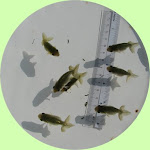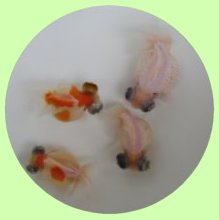The SingPost Goldfish Definitive Stamps 2019
Be like a postage stamp, stick to one thing until you get there.
~ Josh Billings
The image is of a Telescope Eye (a.k.a Dragon Eye) Pearlscale that has been on the main banner of my Facebook page for some years. Born and bred in 2010 in Singapore, it won first prize in the Pearlscale class at the 2011 Aquarama International Goldfish Competition. This uniquely Singaporean creation was the product of a breeding program that I had begun in 2006.
Tank view of the First Local Stamp Pearlscale
The idea of creating a new strain came about in 2005. I wanted to set myself tougher challenges in the goldfish hobby and was determined to refute critics who believed it impossible to produce quality goldfish in tropical Singapore. Thus was the blueprint of the new variety conceived, based upon the Pearlscale variety - one of the most demanding goldfish to properly cultivate.
A big pearlscale from the Little Red Dot:
Size from the top view of the First Local Stamp Pearlscale
My dream was to develop a Pearlscale with an adorable rounded body and short tail; and exotic oriental features in the form of dragon (telescopic) eyes, pom poms (velvety narial bouquets), and topped off with a mini crown. I also wished for it to have a multitude of colour variations and the potential to achieve an impressive size.
It does not take much imagination to realise that my ideas would be accompanied by a engineering challenge - a fish with a short tail on one end having the daunting task of powering a plumpish body which would sport the heavy payloads of dragon eyes, pom poms and a crown at the other end. Balance had to be achieved through careful selective breeding for the optimal backbone structure, body-head-tail proportions, eye size, tail shape and angle. This was important to allow the fish to swim with grace and refined deportment, and live a healthy dignified life.
Dragon Eye Pom Pom Crown Pearlscale came to life in 2013
A goldfish breeding programme is a long term project. It entails knowledge of goldfish genetics and show standards, water quality management, contingency planning, ample pond space and the commitment to track the development of the bloodline.
In livestock breeding, a stable bloodline is one that exhibits a high consistency of desired traits over generations. Outcrossing - ie mixing with unrelated strains or bloodlines - is necessary to introduce new desired features to the baseline pearlscale variety.
Power of the dream
However, outcrossing is akin to shuffling a deck of hitherto ordered cards - once done, it is difficult to predict the hand that will next be dealt. Stable and desired traits may diminish or even disappear in the new hybrid offspring. A bad decision in outcrossing or casualties in brood stock can have catastrophic - or even show stopping - consequences for the whole breeding programme.
In livestock breeding, a stable bloodline is one that exhibits a high consistency of desired traits over generations. Outcrossing - ie mixing with unrelated strains or bloodlines - is necessary to introduce new desired features to the baseline pearlscale variety.
Power of the dream
Tank view of a Singapore Dragon Eye Pom Pom Crown Pearlscale in 2015
Creating a new goldfish variety is a long game of patience with no guarantee of success. The journey was at times lonely, with few fans or believers when it began with the first generation in 2005. Singapore’s tropical climate has allowed me to breed up to 3 generations of goldfish a year (as compared to only one generation in spring for temperate climates like China’s or Japan’s). But even with the quickened progress, it took years to stabilised the new variety.
2019 Dragon Eye Pom Pom Pearl babies 5 month old
Whilst still less known here at home (at least before the stamps were launched!) the Telescope Eye Pearlscale has gained recognition internationally as a uniquely Singapore variety.
However, the quest for “pearl-fection” is a continuing passion and I would hope to continue enhancing the breed for as long as I possibly can.
My heartfelt thanks once again to SingPost for showcasing my work in the prominent way that they have!
Check out some of my blog articles:
My Goldfish Breeding Journey:
~ Dream of a Goldfish Fanatic
~ Aquarama 2011
~ Balance
My Goldfish Artworks:
~ A Minute on Stage is 10 Years of Hard Work
~ The Art of Patience
~ 5 minute Pearlscale
Enjoy more than 100 goldfish articles posted in Goldfish ArtQuatics!!!





















